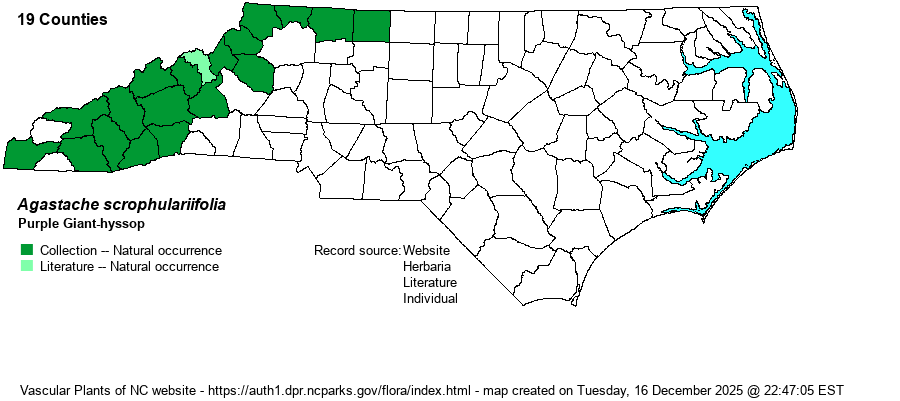| Author | (Willdenow) Kuntze | |
| Distribution | Essentially throughout the Mountains (lacking records from only a few scattered counties), and ranging into the Sauratown Mountains in the northwestern Piedmont.
This is a Northern species ranging from New England south to NJ, PA, and MO, and south mainly in the Appalachians to northern GA. | |
| Abundance | Infrequent to fairly common in the Mountains, and very rare in the Sauratown Mountains. | |
| Habitat | This species is typically on high pH soil, but as such soils are not uncommon in the mountains, it is much more widespread in its habitats than is the similar A. nepetoides in the Piedmont. It prefers partial sunlight, and occurs along rich to mesic hardwood forest edges, roadbanks, meadows, and in open forests, even in bottomlands. It is not numerous in shaded forest interiors. | |
| Phenology | Blooms from July to September, and fruits from September to October. | |
| Identification | This is one of the tallest and most robust native herbs in the state, typically reaching 5-6 feet tall and occasionally to about 8 feet high. It has several branches in the upper portions, and the stem and branches contain numerous pairs of opposite leaves, each being ovate to nearly triangular, with a very short petiole and small serrations; lower leaves can be 4-5 inches long and 2 inches wide, becoming smaller up the stem. The top portions of the stem and branches contain the dense, spike-like flower clusters, each about 4-6 inches long and strongly erect. The numerous, crowded flowers are about 1/3-inch long, light purple, lavender, or pink (or rarely whitish) in color. Unlike with A. nepetoides, where the light yellow flowers are "crowded out" by the green color of the bracts and calyx lobes, in this species the purple or pink "candles" are much more prominent in these colors, and even from a speeding vehicle on a mountain road these colorful spikes are easily visible. Unfortunately, the species is not as common as most biologists would hope for, and it may require a bit of time or effort to catch some of these plants. | |
| Taxonomic Comments | The scientific name has been recently changed from scrophulariaefolia to scrophulariifolia, in line with a general "consensus" of converting the "ae" of many names to "i".
| |
| Other Common Name(s) | None | |
| State Rank | S3 | |
| Global Rank | G4 | |
| State Status | | |
| US Status | | |
| USACE-agcp | | |
| USACE-emp | | |

